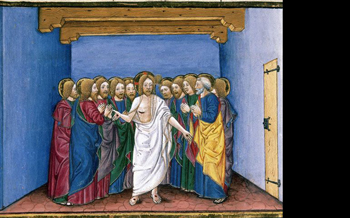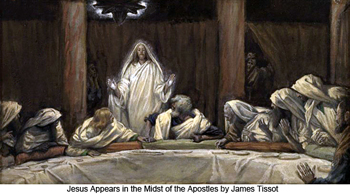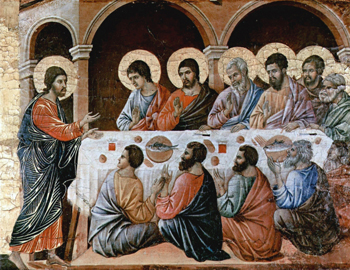For Sunday April 18, 2021
Lectionary Readings (Revised Common Lectionary, Year B)
Acts 3:12-19
Psalm 4
1 John 3:1-7
Luke 24:36b-48
Every year during the Easter season, I see a spate of articles outlining literal versus figurative possibilities for the resurrection. The articles show up in magazines, blogs, and social media feeds, and they wrestle with the same thorny questions each year: did Jesus really return to bodily life after he was crucified, or was the resurrection a metaphor? Was the tomb literally empty, or did the Gospel writers describe it that way to figuratively depict God’s victory over evil, the divine gift of spiritual and psychological enlivening, and the power of memory to keep our loved ones alive after they die? Why is physical resurrection important to so many Christians? Does one have to believe in it to be faithful?
The goal of this essay is not to answer these questions. I understand how complicated they are, I respect the mystery surrounding them, and I grieve the divisiveness, judgmentalism, and trauma they have caused in so many Christian communities. At the same time, I’m drawn to the commission Jesus gives his disciples at the end of our Gospel reading this week. After taking pains to convince his friends that he is not a ghost, after guiding their grief-stricken hearts from terror and disbelief to wonder and joy, he gives them a new vocation in six short words: “You are witnesses of these things.”
This essay is an attempt to bear witness. Specifically, it’s my attempt to describe why I do believe — and cling with all my heart — to the literal, physical resurrection of Jesus, and why that belief is central to my faith.
In our Gospel for this third Sunday of Easter, Luke describes one of Jesus’s post-resurrection appearances to his disciples. They’re sitting around talking — no doubt about Jesus’s death and the bizarre rumors circulating about his missing body — when he appears in their midst out of seemingly nowhere. They respond with terror, as any of us would do if our deceased loved ones suddenly showed up in our living rooms. To allay their fears, Jesus offers his friends the tactile testimony of his body: “Look at my hands and my feet; see that it is I myself. Touch me and see; for a ghost does not have flesh and bones as you see that I have.”
 |
Luke doesn’t tell us whether the disciples take Jesus up on his offer. I imagine the braver ones do — extending a trembling finger to poke Jesus’s skin, or leaning in to peer more closely at his scarred feet — while the more spooked and timid ones hold back.
When hands and feet prove inadequate to convince the disciples of Jesus’s physical presence, he offers up his tongue, teeth, esophagus, stomach, and intestines, too: “Have you anything to eat?” The disciples hand him a piece of broiled fish, and he takes and eats it in their presence. A simple act, but an act that shifts the story. As Jesus chews and swallows, something becomes possible that was impossible before. The disciples lose enough of their fear to draw close and actually listen to what he’s saying, and their receptivity allows Jesus to “open their minds to understand.” By the end of the encounter, they are no longer frightened human beings; they are “witnesses of these things,” emboldened for life and ministry. Simply by expressing physical hunger and accepting bodily nourishment, Jesus turns trauma into communion.
I love this story for the way it grounds divine revelation in the concrete and the ordinary. It is in the presence of skin and bones, taste buds and nerve endings that the disciples come to faith. Indeed, all of Jesus’s post-resurrection appearances in the Gospels center on the physical. Jesus doesn’t manifest as a disembodied voice that waxes eloquent on the philosophical implications of death and life. He shows up with hands and feet, scars and wounds. He receives the tearful embrace of Mary Magdalene, who doesn’t want to let him go. He makes footprints on the Emmaus road with two of his bewildered friends. He tears into hunks of bread with his scarred hands. He chews on a piece of tilapia. He makes a campfire on the beach and cooks breakfast for his friends.
For me, this embodied Jesus of Easter is the Jesus I recognize from the whole witness of the Gospels — and that recognition is both precious and essential. The Jesus of Easter is the Jesus of the Incarnation. The Jesus who grows in a womb, enters the world through a birth canal, sleeps in a feeding trough, and nurses at Mary’s breast. The Jesus who scrapes his knees, roughhouses with his playmates, loses his parents during Passover, and goes through puberty in the backwaters of Nazareth. The Jesus who soaks in the waters of baptism, hungers for bread in the Judean wilderness, weeps at his friend’s grave, flings a whip around the temple, appreciates scented oils on his feet and head, sweats blood in the garden of Gethsemane, and suffers asphyxiation on a Roman cross. “It is I myself,” Jesus tells his wonderstruck disciples as they struggle to reorder all that they know about life and death, souls and bodies, in the aftermath of his astonishing appearance. It is I myself. Me. The one you know. The one you love. The one you trust. Touch me and see.
 |
I know that it might be unfashionable to “need” the resurrection. Isn’t this the criticism so often leveled at Christians? That our faith is a crutch, an opiate, a refusal to face the harsher aspects of reality? But here, too, I will bear witness and insist that I need Jesus’s bodily resurrection precisely because I, too, am embodied. As the ancient Psalmists and prophets so beautifully describe it, my spiritual life is inseparable from my physical one: my heart melts like wax, my throat grows parched, my bones go out of joint, my tears cover my pillow, and my groans, sighs, and moans reach wordlessly for God. Every experience I have of the holy is grounded in my body.
And so I need a Savior with a body like mine — a body that adores, worships, and celebrates, but also a body that fails, ages, aches, breaks, and dies. A body that carries wounds and scars, visible and invisible, fresh and faded. A body that is profoundly and often terrifyingly vulnerable to forces beyond my ability to mitigate or control. A body that is, for the most part, defenseless against injury, violence, illness, injustice, and cruelty. A body that might die — as Jesus himself died — too soon, out of season, away from loved ones, in random, inexplicable, cruelly traumatic circumstances too frightening to contemplate. I need a God who resurrects bodies. A God who honors and even revels in physicality, who sees the danger and damage so often enacted against human flesh, and yet declares with absolute authority and credibility that our endings here and now are not The End. For me, the physical resurrection of Jesus is God's definitive offering of both compassion and justice: all that has been taken, broken, mistreated, wronged, and forgotten, will be restored.
 |
As many of you already know from reading my previous essays, I have two children who have spent the past many years struggling with physical and psychological illnesses. My prayers for their healing here, now, in this life, will never stop. But for me, the resurrection of Jesus is the promise I cling to as a mother, the guarantee that even if my son spends the rest of his days on earth in debilitating pain, even if my daughter’s anxiety and depression don’t abate in this lifetime, there is hope for their healing. There is deep, vast, immeasurable, and indescribable hope. Eschatological hope. Hope beyond hope. My children’s stories — the stories of their precious, divine-image-bearing, struggling bodies — will not end here. As our epistle reading this week so eloquently puts it, “Beloved, we are God’s children now; what we will be has not yet been revealed. What we do know is this: when he is revealed, we will be like him, for we will see him as he is.”
“You are witnesses of these things.” Again, I know that when we speak of resurrection, we’re speaking about a profound mystery. Not for one moment do I claim to understand, or to have a theological monopoly on interpreting the empty tomb. The only posture any of us can honestly assume in the face of such a remarkable story is a posture of humility. And so I write only about what I have come to believe and love, based on my own yearnings, hopes, and prayers. For me, the story of Easter is a story of embodiment, through and through. It’s a story of hands and feet, scars and hungers, skin and bone. “Touch me and see” is the invitation I live for, and somehow, against all odds, I believe it’s an invitation that is trustworthy. An invitation that endures. For all of us, for all bodies, for all time.
Debie Thomas: debie.thomas1@gmail.com
Image credits: (1) National Catholic Reporter; (2) Truthbook.com; and (3) St Chrysostom's Church News and Views.





